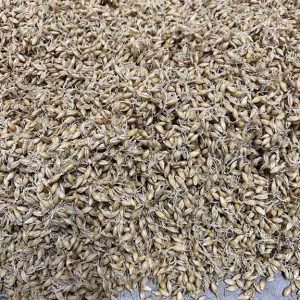ANNAPOLIS, Maryland — In Havre de Grace, there’s a red barn with a white door on Level Road. It looks like your average dairy farm, but on the inside, there are no cows in sight. Instead, the barn is filled with machinery — and bags and bags of barley.
Most barley grown in Maryland would not be stockpiled like it is in this barn. It would be sold and sent off as feed for livestock. But, this barley is turned into malt at one of Maryland’s only malting companies.
There are only three malting companies in Maryland, but maltsters and brewers in the state are generally optimistic that the industry can grow.
Barley and rye, as harvested, do not have the enzymes necessary to create a good alcoholic product, like beer. So, farmers must turn the grain into malt.
Malt is created in three steps.
First, the grain is steeped in water for about 48 hours to allow it to sprout. Then, the sprouted grain is laid out on a floor and is given about three to five days to germinate. Finally, the grain is dried out in a kiln, which indirectly heats the grain and removes the moisture.

The partially germinated grain can then be used in brewing and distilling.
Maryland’s malting industry is so small that it does not register in the U.S. Department of Agriculture’s database, but Greg Clabaugh, of Amber Fields Malting and Brewing in Frederick, said he was not sure why the industry is not larger in Maryland.
About 20 years ago, Clabaugh transitioned from dairy farming to malting because he did not see a great future for the dairy industry. He wanted a business that his children could join if they chose.
But Clabaugh said the malting industry likely has not grown in Maryland because it’s hard for farmers to change their way of business.
Once farmers get comfortable with what they’re doing, “(it’s) hard to take the first chance, the first step” into another industry, Clabaugh said.
Another challenge with malting in Maryland is the climate. Malting barley is mainly grown in cooler and drier climates in states such as Wyoming, North Dakota, Idaho, and Montana, according to a 2018 barley map from the U.S. Department of Agriculture.
Aaron Hopkins of Chesapeake Malting Co., based in Havre de Grace, said that the humidity in Maryland is more conducive to an undesirable fungus called vomitoxin.

Vomitoxin can sometimes be seen as a pinkish color on the grain, but it can also be identified using test kits.
Vomitoxin grows on grains and can cause nausea, vomiting, and other indigestion issues. Hopkins said that the state has strict standards for vomitoxin on malt because it is consumed by humans and not animals.
Annual weather can also be an issue for grain growers. Too much rain can cause the crops to drown, but not enough rain hurts them, too.
Despite potential farming issues, all three malters in the state have been successful in creating usable malt.
“The key is finding the right variety (of grain) for this area,” Clabaugh said.
Danny Buswell of Dark Cloud Malthouse in Cooksville has been malting barley with his business partner for about three years and said they have proven quality grain can be grown and malted in the state.
The biggest challenge all three producers face, they said, is pricing.
Larger malting companies across the country are able to produce higher quantities of malt, which they can sell at lower prices.
“(We) can’t come close to competing on pricing,” Hopkins said.
Larger companies can price their malt around 45 cents to 60 cents a pound, whereas local, craft malt is sold around $1 and $1.10, according to Hopkins.
But, brewers in the area are buying the local products, said Kevin Atticks, executive director of the Maryland Brewers Association.
There are plenty of benefits to the locally sourced malt.
With locally sourced malt, the brewer knows where the product came from. They can build a “deeper relationship” with the brewers, Hopkins said, and can work to customize the product.
Because these businesses malt on a smaller scale, they can be more nimble, Buswell said. Local maltsters can make products that brewers would not necessarily have access to if they bought from larger corporations like Anheuser-Busch or Coors.
“For me and the industry, it’s all about supporting local agriculture,” Atticks said.
Brewers agree.
Tom Barse, owner of Milkhouse Brewery in Mt. Airy, Maryland, said around half of their beers are 100% Maryland grown.
Jeff Ramirez, chief beer officer and co-found of Denizens Brewing Co., with locations in Silver Spring and Riverdale,concurred.
“You always want to support companies surrounding you if you can afford to,” he said.
Maryland brewers said they have been impressed with the malt.
Ramirez said that he has worked with Dark Cloud Malthouse in the past and was impressed by their attention to quality — particularly that the malt was bagged the same day.
As with coffee, Ramirez said, fresher ingredients generally lead to a more aromatic product.
Barse said that using local was worth the price.

“I think our beer is better than using malt that has been stored for a year or two,” Barse said.
The Maryland Brewers Association, along with Clabaugh, Hopkins and Barse, said they could see the malting industry in Maryland growing.
“With all the breweries popping up, someone needs to supply them,” Clabaugh said.
Hopkins and Barse said they believe that growth will happen, but it may be slow.
Maryland farmers do not have the infrastructure to store large amounts of grain, said Barse, but he believes in the next five years it may be possible.
“If a few guys can do it, there are plenty more that can too,” Barse said.
Buswell was a little more hesitant. The craft beer revolution in Maryland has been huge, but the craft malt industry has not been as large, he said.
By looking at his company’s own growth, Ramirez said, it’s hard to move more volume of a product without a more competitive price.
Buswell commented on the differences between Maryland’s industry compared to other states that have seen greater growth.
In New York, local breweries are required to use a certain amount of locally sourced products in their beers. Specifically, 60% of hops must be grown in the state, and 60% of all other ingredients must be grown in the state. Maryland does not have these same requirements.
“On one hand, you hope (the industry) can grow naturally without regulation, but on the other, you don’t know,” Buswell said.
Barse said that government intervention would help, but is not necessary. About 100 years ago, the Maryland industry thrived without any government assistance, but that was before any alcohol taxes, Barse noted.
Overall, Buswell said, he believes there is room for more malt houses in the state if breweries try to use locally grown malt.
Maryland brewers seem up to the challenge.
“Brewers would be excited to use (local malt) products if they’re more accessible,” Barse said.


You must be logged in to post a comment.